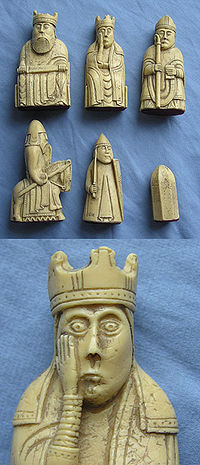Brief History of Scotland
The Kingdom of Scotland was an independent sovereign state before 1707, although it had been in a personal union with the Kingdom of England since James VI of Scotland succeeded to the English throne in 1603. On 1 May 1707 Scotland entered into an incorporating political union with England to create the United Kingdom of Great Britain. This union resulted from the Treaty of Union agreed in 1706 and enacted by the twin Acts of Union passed by the Parliaments of both countries, despite widespread protest across Scotland.
Scottish Treasures:
Lewis Chessmen or Uig Chessmen - The chess pieces consist of elaborately worked walrus ivory and whales' teeth in the forms of seated kings and queens, mitred bishops, knights on their mounts, standing warders and pawns in the shape of obelisks. It is possible that the pieces belonged to a merchant travelling from Norway to Ireland. This seems likely since there are constituent pieces - though with some elements missing - for four distinct sets. Their general condition is excellent and they do not seem to have been used much, if at all.
.
 | 
William Wallace Passport – ON LOAN TO SCOTLAND FROM JANUARY 2012 TO DECEMBER 2014! (see the Celtic League website for more information) The Safe Conduct letter, a letter written by the King Philip IV of France to grant William Wallace safe passage to visit the Pope to gain support for Scotland’s cause, was seized following his capture by the English. The Passport is kept at the UK National Archives in Kew. It is believed to have been in Wallace’s possession when he was betrayed by the Earl of Menteith and arrested in Robroyston, near Glasgow, in August 1305. The document was taken by English forces after Wallace’s 19-day journey to London, where he was convicted of treason before being hanged, drawn and quartered. The passport was actually a letter, granting “Safe Conduct”. Wallace’s letter was written by, granting Wallace safe conduct to travel to Rome where he hoped. |
The Book of Deer - The origin of the book is uncertain, however, it may be the oldest surviving manuscript produced in Scotland and is notable for having originated in what is now considered a Lowland area. The book has 86 folios and measures 54 mm by 107 mm. |  |